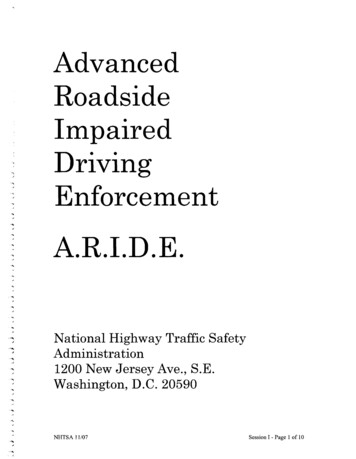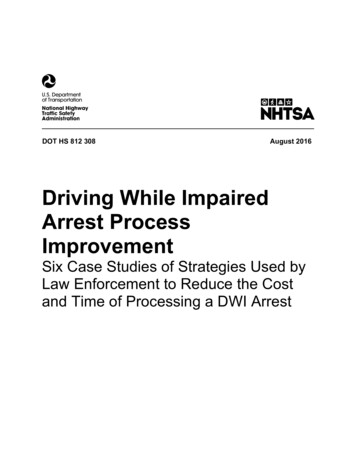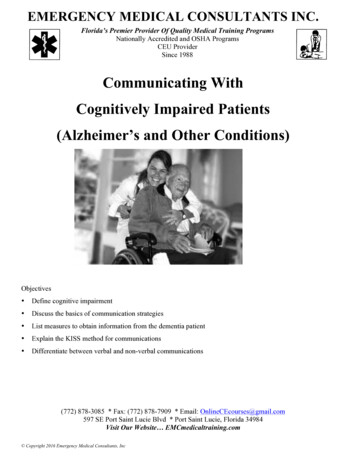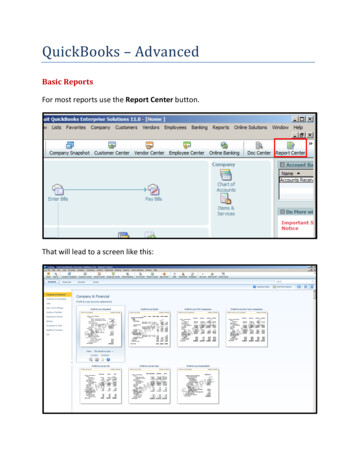
Transcription
ent""if"-,,".,"'b.""' '.,JA.R.I.D.E."'. ,""'".,J.4' .,, ", ,'"'""J".,'",National Highway Traffic SafetyAdministra tion1200 New Jersey Ave., S.E.Washington, D.C. 20590"" ,"",, ,""4'",""."",NHTSA 11107Session I - Page 1 of 10
Session IIntroduction and OverviewNHTSA 11107Session I - Page 2 of 10
SESSION IIntroduction and Overview Drugs and HighwaySafetyUpon successfully completing this session, the participant will be able to:1.Explain the goals and objectives of this course2.Identify the elements of the drug problem as it relates to highway safety3.Define and describe the impaired driving enforcement programs4.Understand the roles and responsibilities of the Drug Recognition Expert (DRE)and how this course supports the Drug Evaluation and Classification (DEC)program5.Define the term drug in the context of traffic safety and impaired drivingenforcement as referenced in the DEC programContent SegmentsLearning ActivitiesDescribe the course to the classGoal of the courseList of activities & scheduleInstructor introductionsInstructor-led presentationInstructor-led presentationSFST proficiency requirementsPre-course knowledge assessmentWhat is a drug?Statistics & researchInstructor-led presentationStudent-assessmentInstructor-led presentationInstructor-led presentationUS and other countriesGeneral alcohol and drug usePrevalence of impaired drivingImpaired driving enforcement programsRoles and responsibilities of the DREInstructor-led presentationInstructor-led presentationInstructor-led presentationInstructor-led presentationInstructor-led presentationNHTSA 11107Session I - Page 3 of 10
Course IntroductionMany law enforcement officers are trained in Standardized Field Sobriety Testing(SFST) and use the skills gained in the course as part of their overall enforcement ofdriving while impaired (DWI) laws. Additionally, some officers complete more advancedtraining through the Drug Evaluation and Classification (DEC) program and becomeDrug Recognition Experts (DRE). This course is not designed as a substitute to the DECprogram and will not qualify or certify an individual as a DRE. This course is intended tobridge the gap between the SFST and DRE courses and to provide a level of awareness tothe participants, both law enforcement and other criminal justice professionals, in thearea of drug impairment in the context of traffic safety. Based on that premise, theAdvanced Roadside Impaired Driving Enforcement (ARIDE) course was developed withthe following goals in mind:This course will train law enforcement officers to observe, identify and articulate thesigns of impairment related to drugs, alcohol, or combination of both, in order toreduce the number of impaired driving incidents as well as crashes which result inserious injuries and fatalities.This course will educate other criminal justice professionals (prosecutors,toxicologists, judges, etc.) to understand the signs of impairment related to drugs,alcohol, or combination of both, to enable them to effectively work with lawenforcement in order to reduce the number of impaired driving incidents as well ascrashes which result in serious injuries and fatalities.In order to deal with impaired drivers on our roadways, it important for the lawenforcement community and other criminal justice professionals to be aware of the signsand symptoms of impairment related to drugs, alcohol, or combination of drugs andalcohol as well as their effects on driving. In addition to identifying the impaired driver,law enforcement agencies need to have the proper information to utilize their availableresources including DREs and appropriate screening methods (blood, urine, or saliva).Criminal justice professionals such as prosecutors and toxicologists must alsounderstand the impaired driving detection process in order to support enforcementefforts, which will increase the probability of successful prosecution and adjudication.The traffic safety community is well aware that it is essential to address bothenforcement and adjudication in order to effectively impact DWI incidents as well asassociated crashes.In order to meet these goals, this course will train participants to:1. Define and describe the relationship of drugs to impaired driving incidents.2. Demonstrate, articulate, and properly administer the Standardized FieldSobriety Tests proficiently.NHTSA 11/07Session I - Page 4 of 10
3. Observe, identify and articulate the observable signs of drug impairment withthe established seven drug categories associated with DEC program.4. Recognize possible medical conditions, which may mimic the obvious observablesigns of impairment.5. Identify, document and describe indicators observed and information obtainedrelated to impairment which leads to the arrest/release decision.6. Articulate through testimony, impairment related to alcohol, drugs orcombination of both based on a complete investigation.This course is divided into sessions which are designed to provide the participant with anoverview of the issue of impaired driving, the effects of drugs and alcohol on a person'sability to operate a vehicle safely, as well as demonstrate methods of identifying andprocessing the impaired driver. The following summarizes the sessions contained in theARIDE course: Introduction & Overview of Drugs and Highway SafetySFST Update, ReviewProficiency ExaminationDrugs in the Human BodyObservations of Eyes and other Sobriety Tests to Detect Alcohol and DrugImpairmentSeven Drug CategoriesEffects of Drug CombinationsPre- and Post-Arrest ProceduresLegal Issues Associated with Impaired DrivingThis course is designed to build on the Standardized Field Sobriety Test practitionercourse. In order for the participant to effectively utilize the information presented in thiscourse, NHTSA has set a prerequisite of SFST proficiency. The participant will receive ashort review and update for the SFSTs as part of Session II of this course. Aftercompleting that session, the participant will be required to pass a SFST proficiencyevaluation. Failure to successfully complete the SFST proficiency evaluation will resultin dismissal from class.Note: See the form in Session III for additional details.NHTSA 11107Session I - Page 5 of 10
What is a Drug?There are many definitions for the word drug. Charles Levinthal's text, Drugs, Behaviorand Modern Society, offers a general definition which describes a drug as a chemicalsubstance that, when taken into the body alters the structures or functioning of the bodyin some way, excluding those nutrients considered to be related to normal functioning.The National Highway Traffic Safety Administration's (NHTSA) impaired drivingtraining programs require a more specific definition since the ultimate goal is to decreaseimpaired driving incidents, crashes and fatalities.For the purpose of this course, a drug is defined as:"Any substance, which when taken into the human body, can impair the abilityof the person to operate a vehicle safely."It should be noted that each state may have specific criteria related to the definition of adrug. Participants should become familiar with their state's specific statutes in this area.Understanding the Problem - Research & StatisticsThe National Survey on Drug Use and Health (NSDUH), previously known as theHousehold Use Survey, is a useful report which is produced by the Department of Healthand Human Services' (DHHS) Substance Abuse and Mental Health ServicesAdministration (SAMHSA). The report provides a thorough overview of drug and alcoholuse in the general population.Alcohol and Drug UseSocial drinking is considered acceptable in many societies. It is important to understandthe use of alcohol in the context of society since it is related to the enforcement andadjudication of DWI offenses. The NSDUH reports that 119 million (50.1 %) peopleconsider themselves drinkers and 14% of this group describe themselves as heavydrinkers. Additionally, the survey indicated that 19.5 million people or 8.2% of thepopulation have used illicit drugs in the past month.Although these statistics are significant, it is reasonable to assume that the problem iseven larger when you consider legal or prescription drugs used in a manner other thanfor what they have been prescribed or produced.When we look at drug use specifically, it is helpful to see the trends based on specifictypes of drugs. The following summarizes the usage information as reported by theNSDUH Survey (2003): 14.6 million people consider themselves current marijuana users54.2% only use marijuana20.6% use marijuana in combination with other drugsNHTSA 11107Session I - Page 6 of 10
75% of current illicit drug users also use marijuanaThe NSDUH Survey provides additional detail on the types of drugs which are commonlyused in the United States. The following table summarizing the current illicit drug use ordrugs used in a manner other than medically intended:(in Millions)Type of Drug Users2.3 CocaineLO Hallucinogens Psychotherapeutics (Prozac, Norpramin, etc.)6.3 Pain relievers (Oxycontin, Vicoden, etc.)4.71.8 Tranquilizers (Xanax, Librium, etc.)1.2 Stimulants0.3 SedativesDriving Under the InfluenceAfter illustrating the usage problem based on the information presented in the NSDUHSurvey, the next step is to understand the magnitude of the problem of individualsdriving while impaired by drugs and alcohol.The survey tells us that males are twice as likely as females to drive under the influenceof alcohol. Overall, 13.6% or more than 32 million people reported that they had driven atleast once in the last year under the influence of alcohol. That further translated intoapproximately 30% of minors (16-20 years of age) and 29% of those between the ages of21 and 25 years of age. Although less than alcohol, those operating a motor vehicle underthe influence of illicit drugs at least once during the last twelve months was significant.The survey states that approximately 5% of the population or 11 million people droveunder the influence of illicit drugs during the last year.This survey does not describe statistics related to those who drive impaired byprescription or other legal compounds. It is important that participants in this courseunderstand the prevalence of alcohol and drug use as well as the frequency by whichthese individuals drive under the influence of impairing substances. The NSDUH Surveyprovides the participant with a strong overview of the problem at the national level.Participants are encouraged to understand the issues related to alcohol and drugimpaired driving in their respective states and/or communities.Impaired Driving Enforcement Systems NHTSA supports enforcement and adjudicationthrough a variety of national and state-level programs. One of the most critical supportactivities NHTSA provides is training. This training is part of a continuum of educationto assist law enforcement officers and other criminal justice professionals in reducing thenumber of alcohol and/or drug related driving incidents, crashes and fatalities.The SFST practitioner course lays the cornerstone for a system of impaired drivingtraining and enforcement. Proficiency in the SFST skills provides a foundation for thiscourse as well as the DEC program. In addition to training, the SFST program should beNHTSA 11/07Session I - Page 7 of 10
part of all alcohol and drug impaired driving enforcement initiatives and is a critical partof the prosecution process. As part of an overarching impaired driving agenda, NHTSAsupports programs at the federal level as well as funds programs at the state and locallevels through their regional offices and state highway safety representatives. Theseprograms include enforcement, media, evaluation and training. In addition to targetingdeterrence, NHTSA advocates various prevention and adjudication programs.Standardized Field Sobriety Testing (SFST) ProgramThe SFST battery is a set of tests, including Horizontal Gaze Nystagmus (HGN), Walk and-Turn (WAT) and One-Leg Stand OLS). These tests are designed to be administeredand evaluated in a standardized manner to obtain validated indicators of impairmentbased on NHTSA supported research. The SFSTs are part of the overall DWI detectionprocess which includes three phases: Vehicle in Motion, Personal Contact, and Pre-ArrestScreening. The SFST program and test battery serves as the foundation for impaireddriving enforcement. It is critical that these tests be performed and interpreted properly.Drug Evaluation and Classification (DEC) ProgramThe ultimate goal of the DEC program is to help prevent crashes and avoid deaths andinjuries by improving enforcement of drug-impaired driving violations. The participant istrained to conduct detailed evaluations and obtain other evidence that can be articulatedfor the purposes of prosecution. A participant who successfully completes all phases ofthe DEC program is known as a DRE. They can reach reasonably accurate conclusionsconcerning the category or categories of drugs or medical conditions causing theimpairment observed in the subject. Based on these informed conclusions, the DRE canrequest the collection and analysis of an appropriate biological sample (blood, urine orsaliva) to obtain corroborative, scientific evidence of the subject's drug use.Important Note: The successful completion of the ARIDE coursewill NOT certify the participant as a DRE.Drug Impairment Training for Educational Professionals (DITEP)The purpose of the DITEP training is to provide school administrators, teachers, andnurses with a systematic approach to recognizing and evaluating individuals in theacademic environment who are impaired by drugs. This training is not intended toqualify participants as a DRE, but is intended to aid in the evaluation anddocumentation of those subjected of being impaired by drugs.Roles & Responsibilities of the Drug Recognition ExpertThe DRE completes eighty hours of classroom training, field certifications, and acomprehensive final knowledge examination to acquire their initial certification. In orderto retain their certification, the DRE must participate in continuing education coursesand complete a recertification training course every two years. They must also maintaina log of all evaluations completed in training and as part of any enforcement activities.NHTSA 11107Session I - Page 8 of 10
They are also required to meet other administrative requirements as established in theInternational Association of Chiefs of Police (IACP) International Standards governingthe DEC program.Based on their training, the DRE is able to conduct a standardized and systematic 12 step evaluation to determine whether an individual is under the influence of a drug(s)other than or in addition to alcohoL DREs work individually and in conjunction withother enforcement personnel to conduct these evaluations. After completing theevaluation, the DRE formulates an opinion as to which drug category(s) is impairing theperson being evaluated. The DRE is able to testify to the general evaluation process asprescribed by the DEC training curriculum as well as the specific signs and symptomsnoted and associated with an evaluation conducted on the arrested subject.The ARIDE course was designed with a dual purpose. First, the ARIDE program willallow the participant to build on the knowledge gained through their training andexperience related to the SFSTs. Many law enforcement officers have encounteredindividuals who appear to be impaired by a substance other than alcohol or seem to bedisplaying signs and symptoms which are inconsistent with their BAC test results.Secondly, this course will provide additional information which can assist the officer ineffective observation and interview techniques related to driving while impaired byalcohol, drugs, or a combination both.One of the desired outcomes of this course is the participant will better understand therole of the DRE and will be able to use their expertise more effectively. For thosecommunities with no DREs or limited access to their services, this course will helpofficers make informed decisions related to testing, documenting, and reporting.The second benefit of this course in relation to the DEC program is that students willreceive information which will help them better assess impaired subjects. This trainingand subsequent field experience will demonstrate the value of having a DRE on staff inan agency and may serve as motivation for the individual officers to attend a DEC coursein the future. A subsequent result of this course will facilitate better utilization of DREs.NHTSA 11/07Session I - Page 9 of 10
Test your knowledge:1. What is the definition of the term drug?NHTSA 11107Session I - Page 10 of 10
Session IIStandardized Field Sobriety TestsUpdate and ReviewNHTSA 11107Session II - Page 1 of 17
SESSION IISFST Update and ReviewUpon successfully completing this session, the participant will be able to:1.Understand the results of selected SFST validation studies2.Define and describe the SFSTs3.Define nystagmus and distinguish between the different types4.Describe and properly administer the three SFSTs5.Recognize, document, and articulate the indicators and clues of the three SFSTs6.Identify the limitations of the three SFSTsContent SegmentsLearning ActivitiesSFST Validation StudiesOverview of Selected Types of NystagmusInstructor-led presentationInstructor-led presentationStandardized Field Sobriety TestsHorizontal Gaze NystagmusPractice HGNWalk-and-TurnPractice Walk-and-TurnOne-Leg StandPractice One-Leg StandNHTSA 11107Instructor-led presentation& demonstrationParticipant practice sessionInstructor-led presentation& demonstrationParticipant practice sessionInstructor-led presentation& demonstrationParticipant practice sessionSession II - Page 2 of 17
Overview of the SFST Validation StudiesFor many years, law enforcement officers have utilized field sobriety tests to determine aperson's impairment due to alcohol influence. The performance of the individual on thosefield sobriety tests was used by the officer to develop probable cause for an arrest and asevidence in court. A wide variety of field sobriety tests existed and there was a need todevelop a battery of standardized and validated tests.Beginning in late 1975, scientific research studies were sponsored by NHTSA through acontract with the Southern California Research Institute (SCRI) to identify roadside fieldsobriety tests which were accurate indicators of impairment. SCRI conducted severalresearch projects and published the following three reports: California: 1977 (Lab)California: 1981 (Lab and Field)Maryland, DC, VA, NC: 1983 (Field)SCRI traveled to law enforcement agencies throughout the United States to select themost commonly used field sobriety tests. Six tests were used in the initial stages of thisstudy. Laboratory research indicated that three of these tests, when administered in astandardized manner, were a reliable test battery for identifying individuals under theinfluence of alcohol at BACs above 0.10. The recommended battery included the followingSFSTs: Horizontal Gaze Nystagmus (HGN) Walk-and-Turn (WAT) One-Leg Stand (OLS)SCRI analyzed the laboratory test data and determined that: HGN, alone, was 77% accurateWAT, alone, was 68% accurateOLS, alone, was 65% accurateCombination of HGN and WAT yield an accuracy rate of 80%There were three additional research studies. These studies were conducted in the fieldby trained, experienced officers and validated the three test battery at 0.08. The SFSTvalidation studies were conducted in Colorado (1995), Florida (1997) and San Diego(1998).The Colorado SFST validation study was the first full field study that utilized lawenforcement personnel experienced in the use of SFSTs. The results of this studyindicated that correct arrests decisions were made 93% of the tim
The SFST practitioner course lays the cornerstone for a system of impaired driving training and enforcement. Proficiency in the SFST skills provides a foundation for this course as well as the DEC program. In addition to training, the SFST program should be . NHTSA 11/07 Session I -Page 7 of 10











